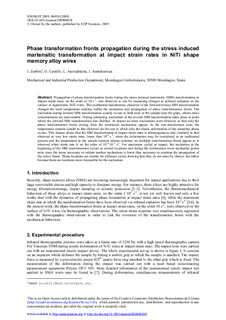| dc.rights.license | Attribution-NonCommercial 4.0 International | * |
| dc.contributor.author | Aretxabaleta, Laurentzi | |
| dc.contributor.author | Aurrekoetxea, Jon | |
| dc.contributor.author | Zurbitu, Javier | |
| dc.contributor.author | Castillo López, Germán | |
| dc.date.accessioned | 2022-05-24T12:09:58Z | |
| dc.date.available | 2022-05-24T12:09:58Z | |
| dc.date.issued | 2009 | |
| dc.identifier.other | https://katalogoa.mondragon.edu/janium-bin/janium_login_opac.pl?find&ficha_no=68955 | en |
| dc.identifier.uri | https://hdl.handle.net/20.500.11984/5584 | |
| dc.description.abstract | Propagation of phase transformation fronts during the stress induced martensitic (SIM) transformation at impact strain rates, on the order of 10 s-1, was observed in situ by measuring changes in infrared radiation on the surface of superelastic NiTi wires. The exothermic/endothermic character of the forward/reverse SIM transformation changes the local temperature making visible the nucleation and propagation of phase transformation fronts. The nucleation during forward SIM transformation usually occurs at both ends of the sample near the grips, where stress concentrations are unavoidable. During unloading, nucleation of the reverse SIM transformation takes place at point where the forward SIM transformation was finished. At impact no more nucleations were observed so that only the phase transformation fronts arising from the mentioned nucleations appear. In the non-transformed zone, the temperature remains similar to that observed for the test in which only the elastic deformation of the austenitic phase occurs. This feature shows that the SIM transformation at impact strain rates is inhomogeneous and, similarly to that observed at very low strain rates, lower than 10-4 s-1, when the deformation may be considered as an isothermal process and the temperature in the sample remains almost constant, no multiple transformation fronts appear as is observed when strain rate is on the order of 10-4-10-2 s-1. For specimens cycled at impact, the nucleation at the beginning of the SIM transformation occurs at several locations and during the deformation more nucleation points arise since the stress necessary to initiate another nucleations is lower than necessary to continue the propagation of the active fronts. These locations are similar for different cycles showing that they do not arise by chance, but rather because there are locations more favourable for the nucleation. | en |
| dc.language.iso | eng | en |
| dc.publisher | EDP Sciences | en |
| dc.rights | © Owned by the authors, published by EDP Sciences 2009 | en |
| dc.rights.uri | http://creativecommons.org/licenses/by-nc/4.0/ | * |
| dc.title | Phase transformation fronts propagation during the Stress Induced Martensitic transformation in NiTi Shape Memory Alloy wires at impact strain rates | en |
| dcterms.accessRights | http://purl.org/coar/access_right/c_abf2 | en |
| dcterms.source | The 8th European Symposium on Martensitic Transformations : program and abstract book : ESOMAT. Prague, 2009 | en |
| local.contributor.group | Tecnología de plásticos y compuestos | es |
| local.description.peerreviewed | true | en |
| local.identifier.doi | https://doi.org/10.1051/esomat/200906038 | en |
| oaire.format.mimetype | application/pdf | |
| oaire.file | $DSPACE\assetstore | |
| oaire.resourceType | http://purl.org/coar/resource_type/c_c94f | en |
| oaire.version | http://purl.org/coar/version/c_970fb48d4fbd8a85 | en |








